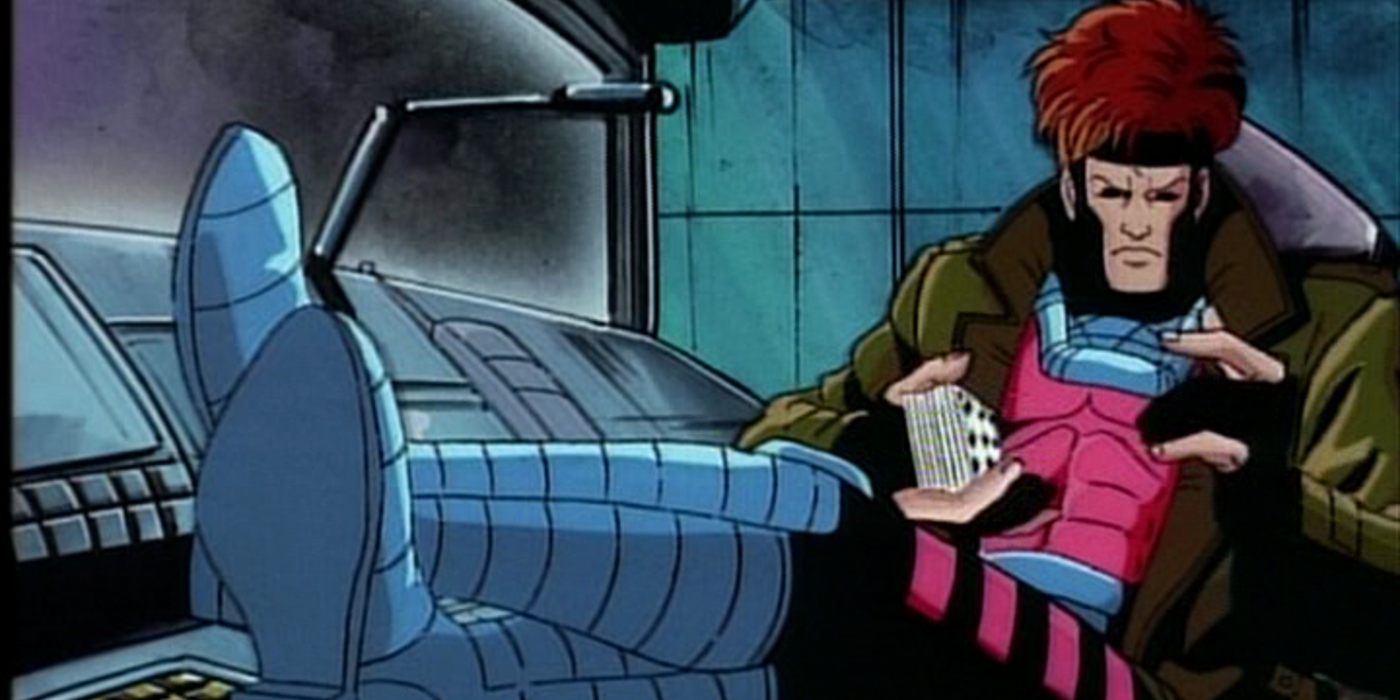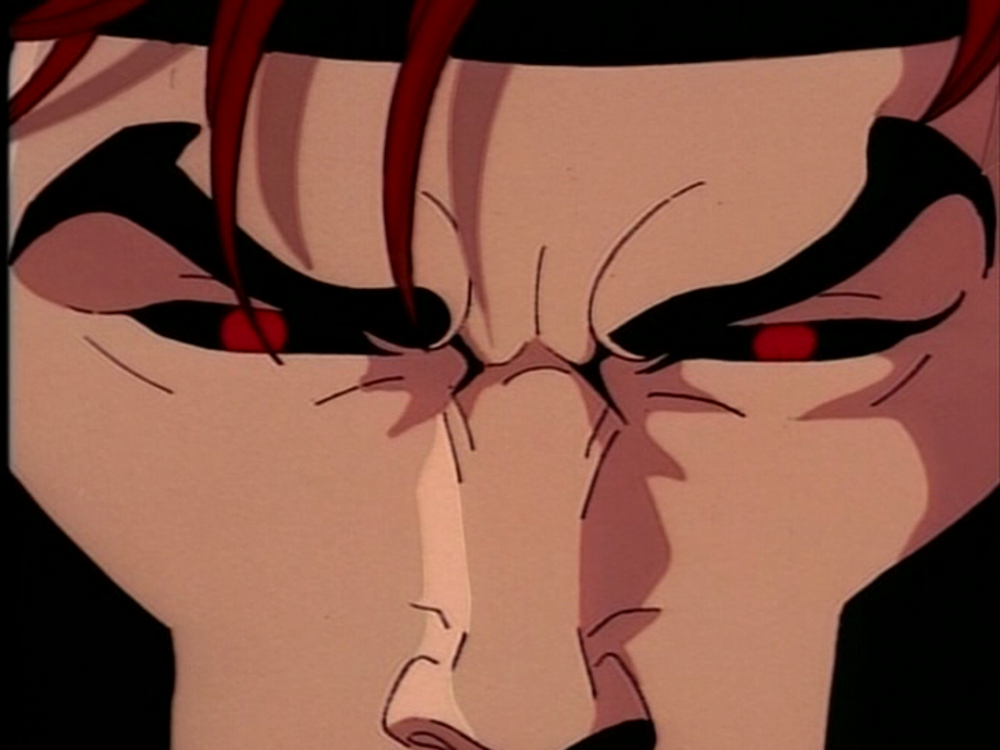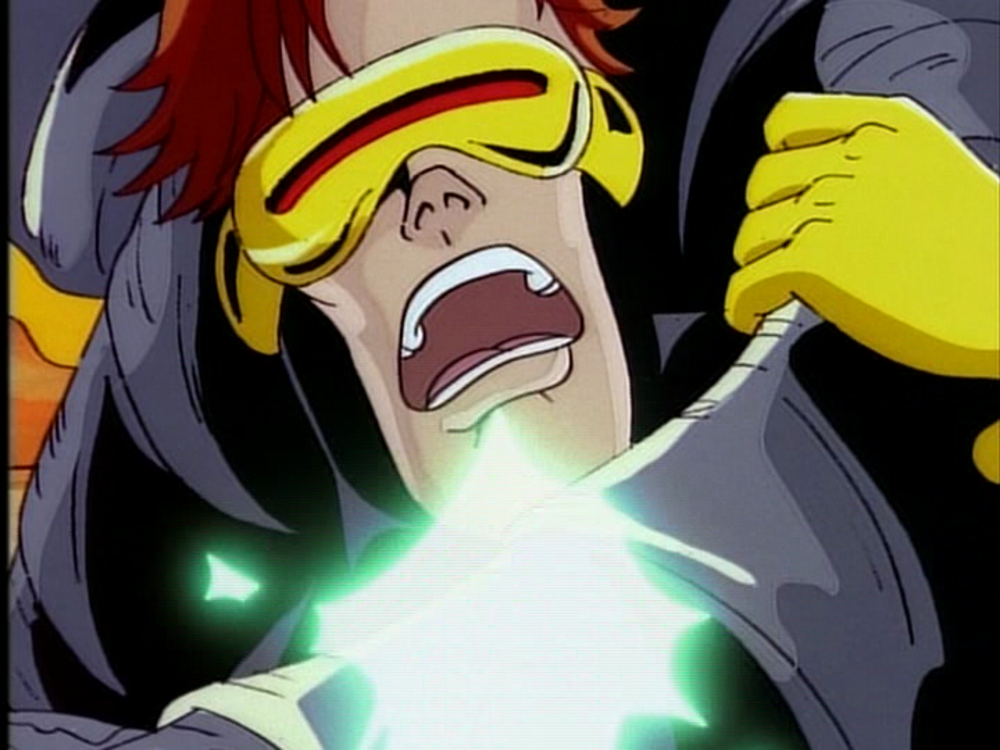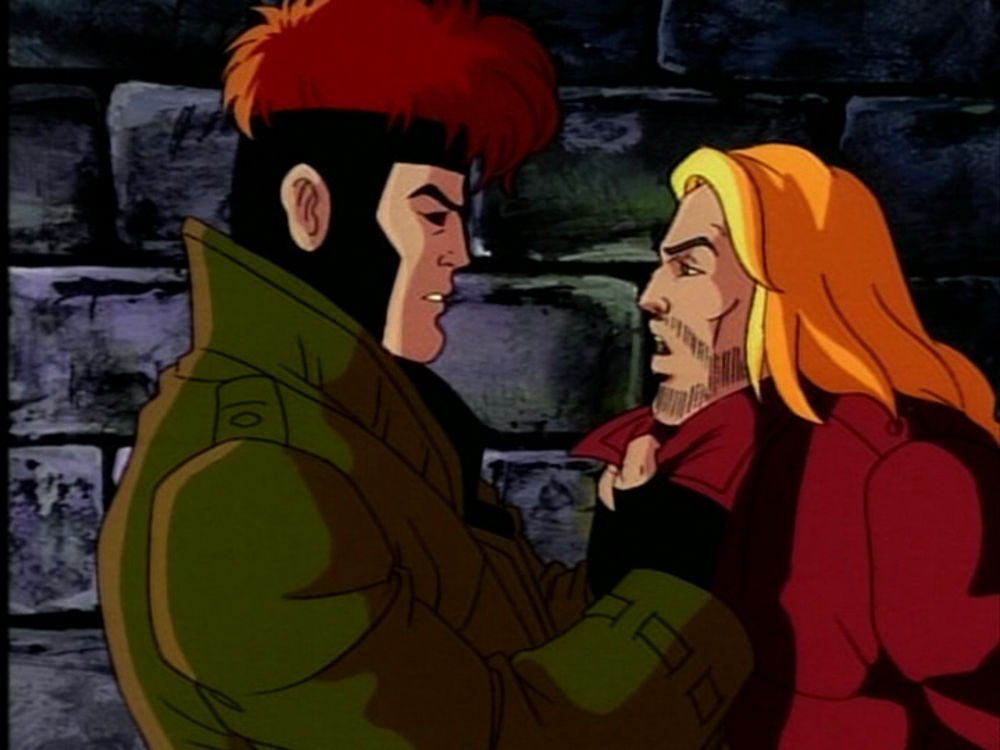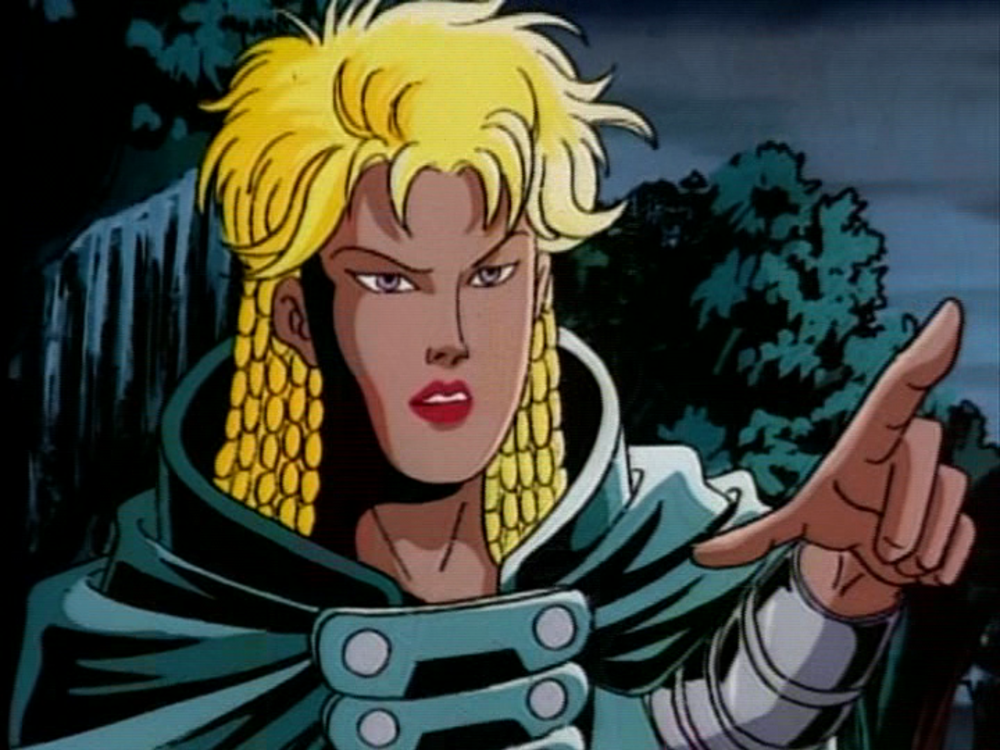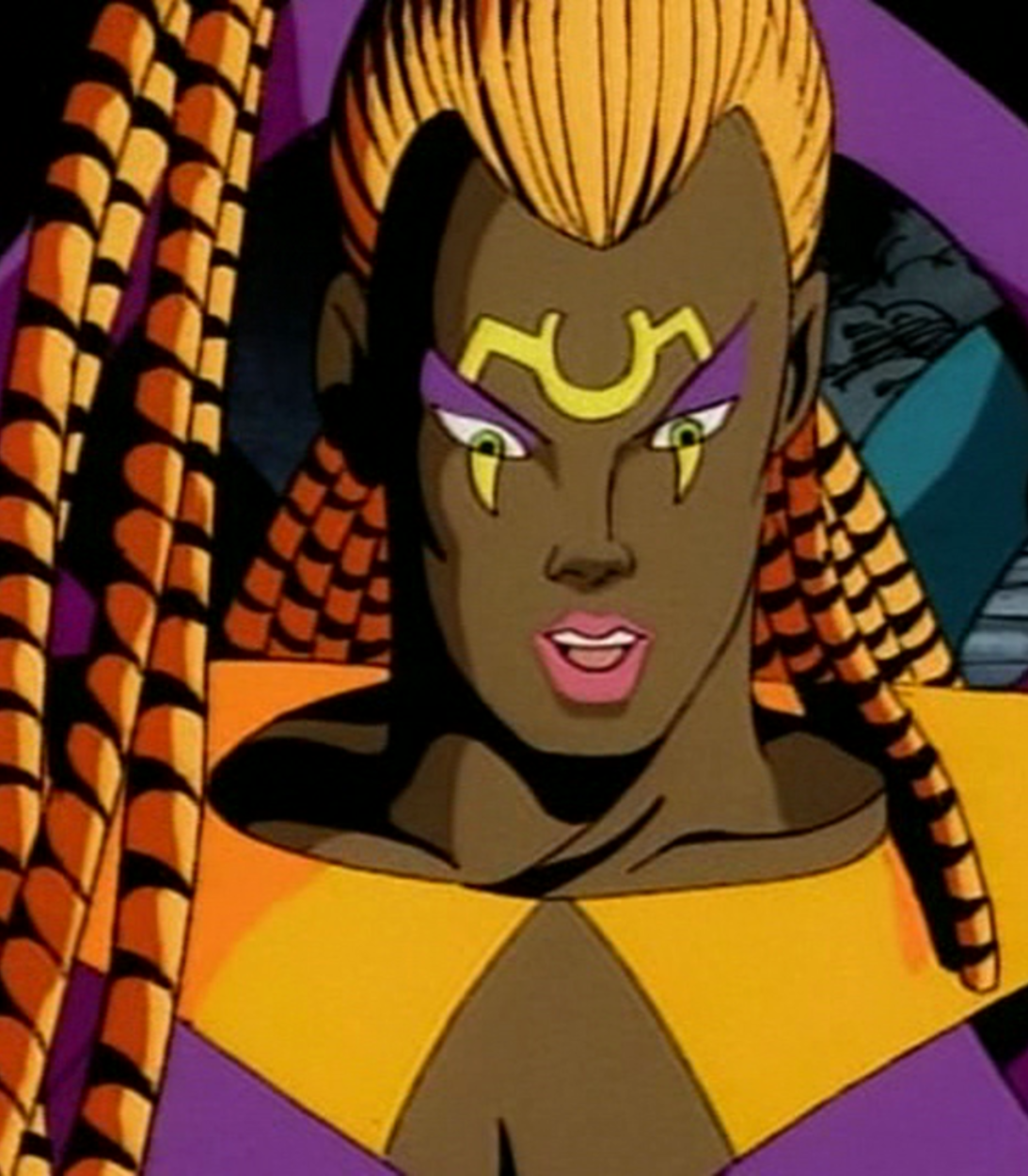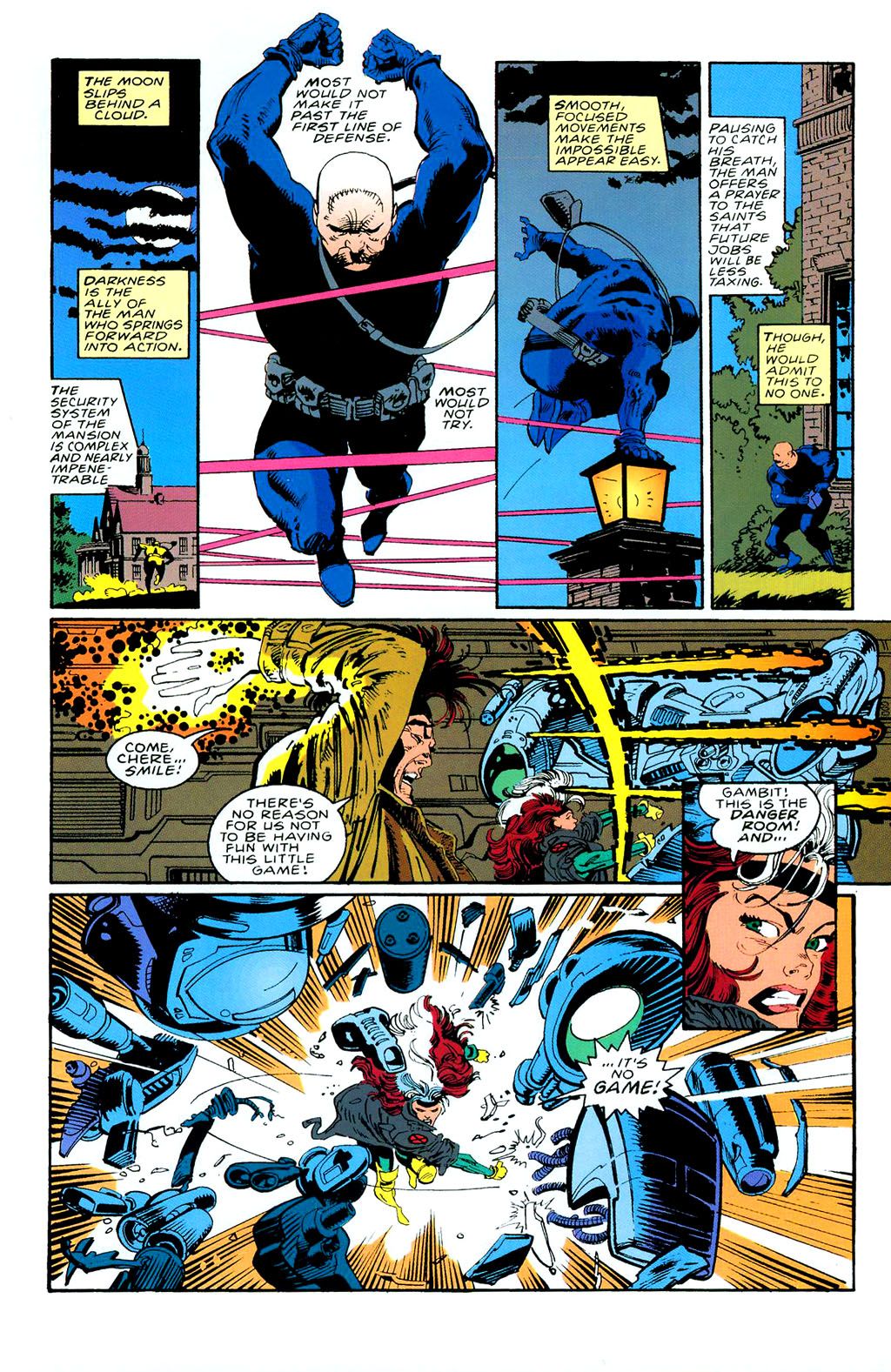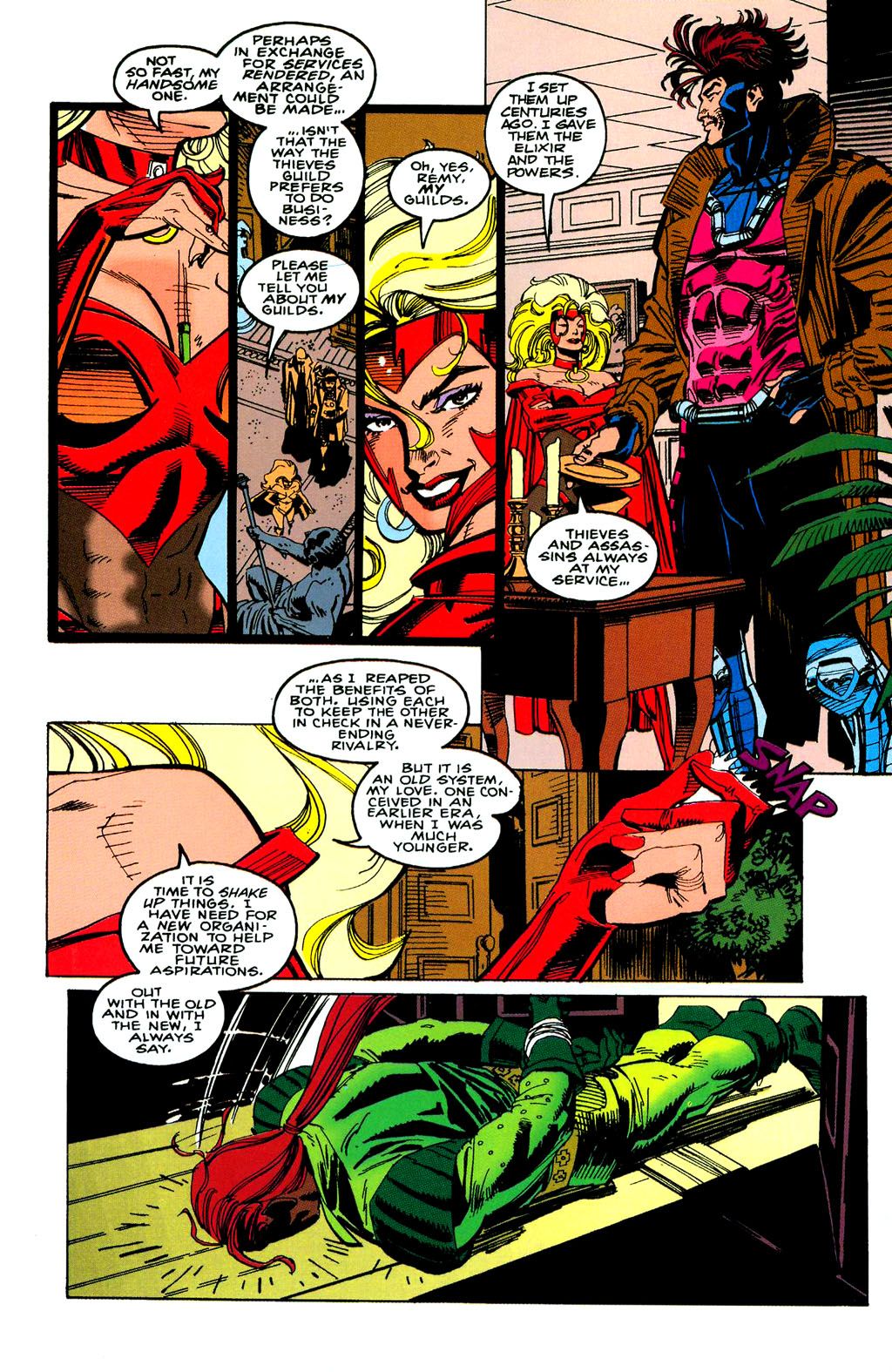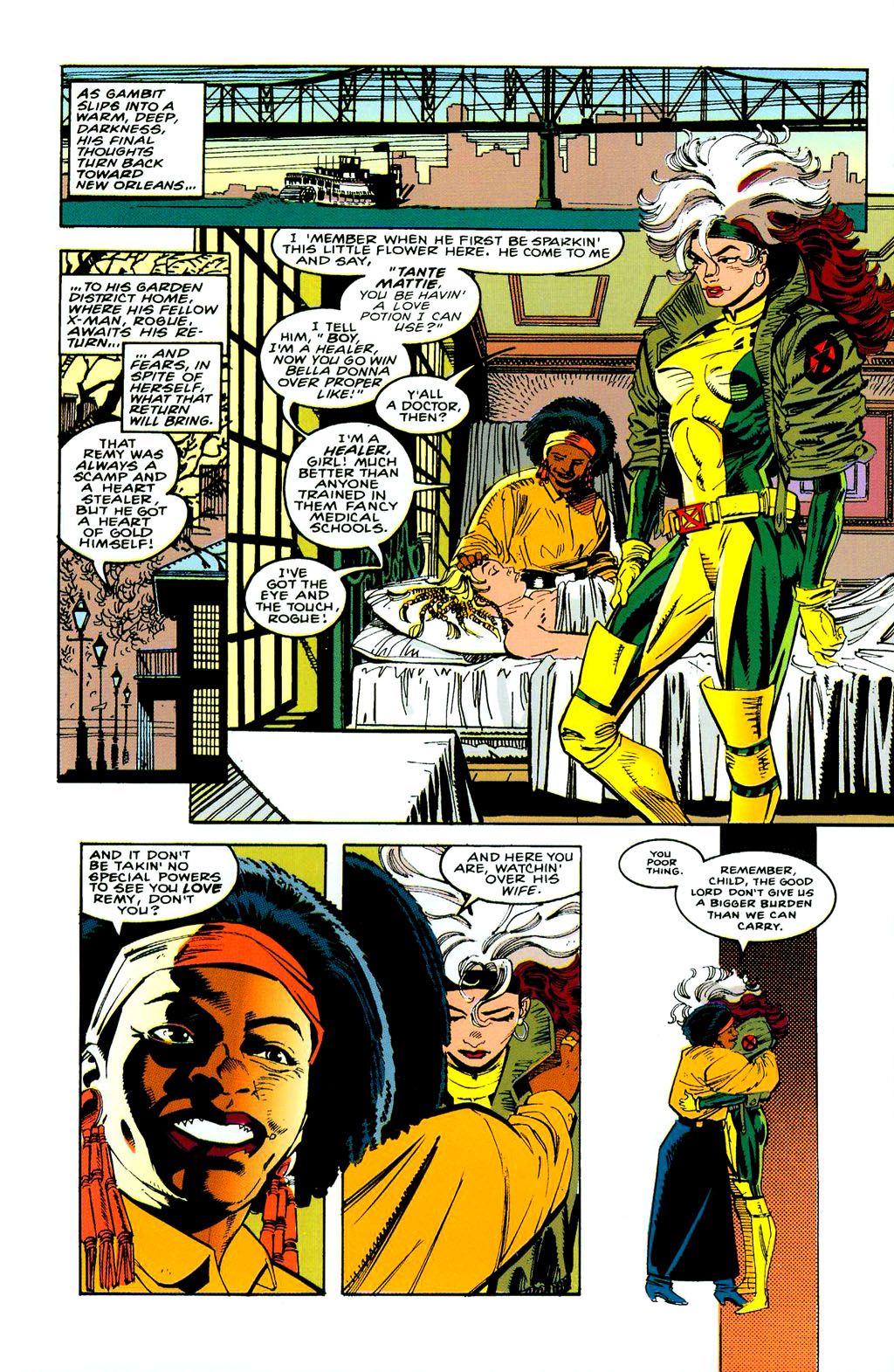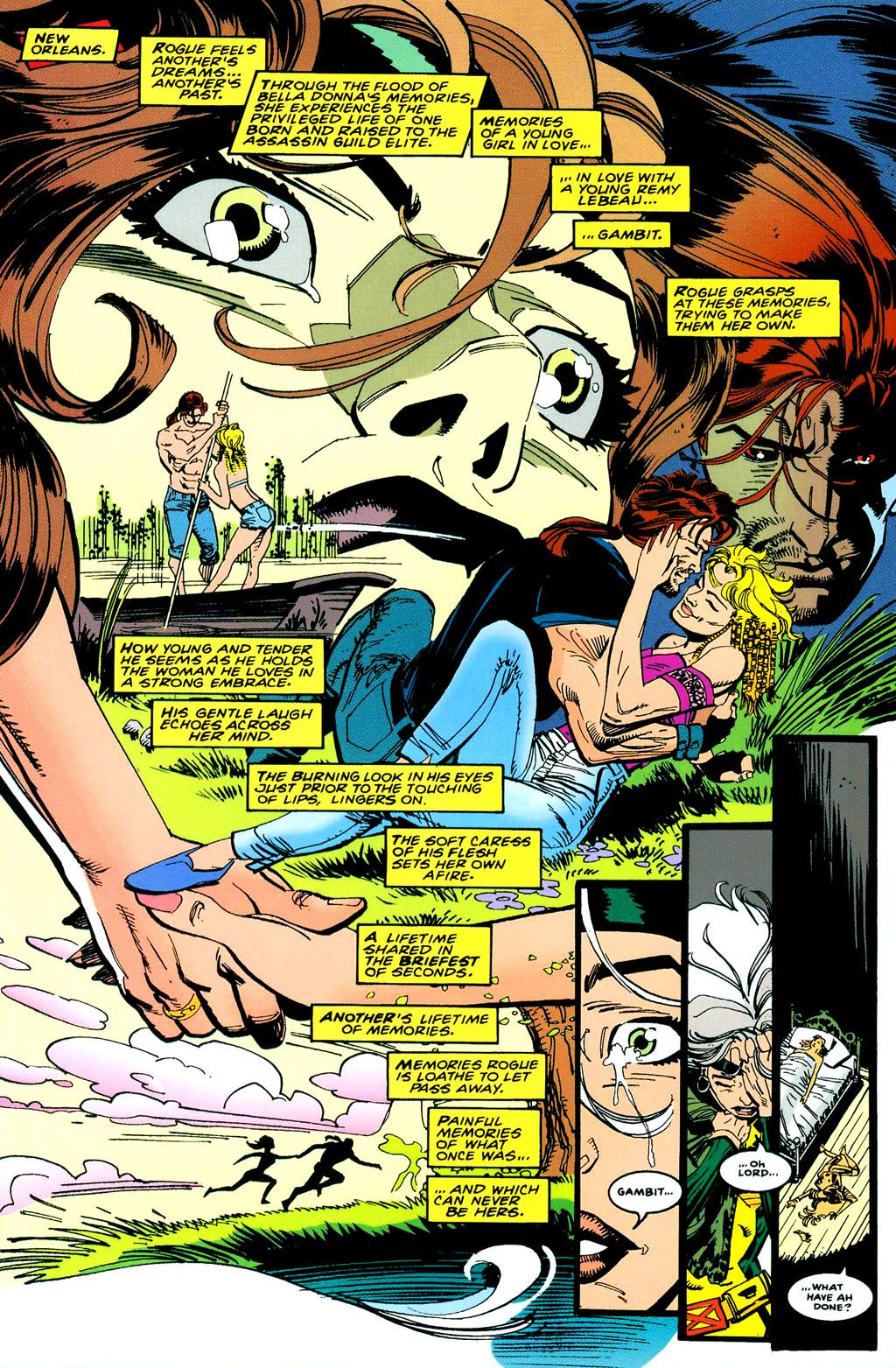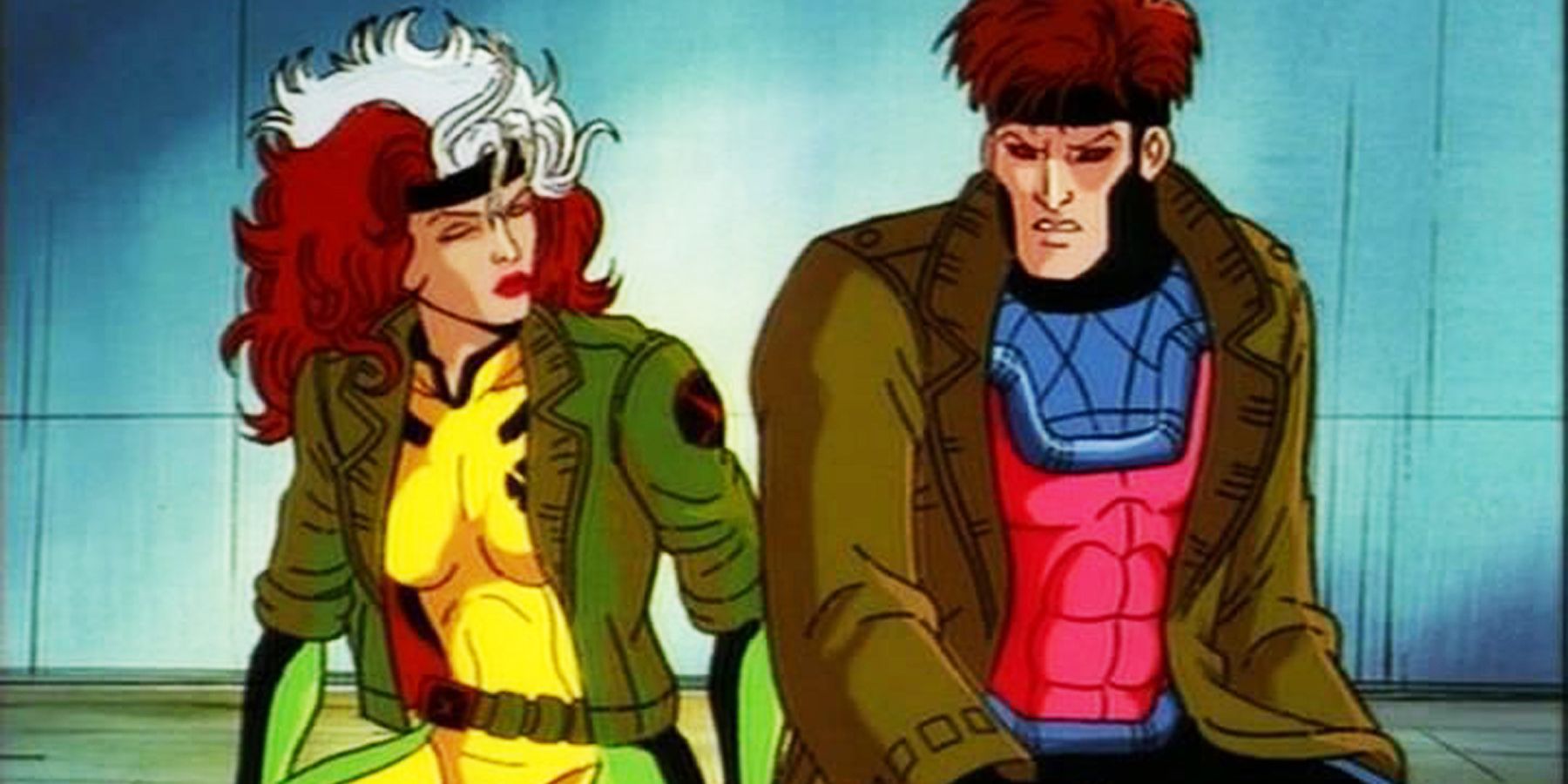Welcome to Adventure(s) Time's 97th installment, a look at animated heroes of the past. This week, the Gambit spotlight episode of X-Men, which just so happened to draw inspiration from a Gambit miniseries that hadn't even wrapped up yet.
Following a highly successful debut season, the producers of X-Men: The Animated Series went into Year 2 with a clever plan: Before the big finale, there's a season-long subplot in each episode. (A concept sneaked past the network.) The main stories, however, would mostly serve as character spotlights. And in 1993, few mutants were hotter than Gambit.
As showrunner Eric Lewald explains in his book, Previously on X-Men, "We set up the character of Gambit to be mysterious, in part because in 1992 we, and even Marvel, knew so little about him." Debuting on Dec. 4, 1993, the pun-tastically titled "X-Ternally Yours" from writer Julianne Klemm attempts to provide some answers.
The episode opens with Gambit overseeing Cyclops' Danger Room training session. Cyclops demands Gambit turn up the intensity, not long before Gambit is distracted by a phone call. The preoccupied Gambit nearly kills Cyclops by accidentally setting the intensity too high.
Some episodes would open with these quick action pieces that don't have much to do with the plot. But what stands out about this one is just how dark the color palette has become. Season 2 drastically altered the pastel look of the first season, producing a shadowy ambiance that better suited the show's reality. I don't recall the series ever looking as dark in the later seasons, but it does create an ominous feeling for this batch of episodes.
After the teaser, Gambit reveals the source of the call to Rogue: His brother Bobby has been abducted by his family's rivals, the Assassins Guild. Traveling alone to New Orleans, Gambit is reunited with his Thieves Guild brethren. We discover this is all a scheme from Gambit's ex, Bella Donna, to force him into marriage.
Bella Donna has never been overly likable in the comics, but here she's pretty horrific. Not only is she keeping Gambit on a leash through a wedding band that shoots waves of debilitating pain through his body, but she's also sabotaged the Thieves Guild tithe to the returning External. Now, what does that mean?
We're entering an area of X-continuity that, simply put, doesn't have many fans. Even though these stories first appeared during the mutants' massive boom in popularity, in an era that to this day carries heavy nostalgia for fandom, you won't find too many supporters of the Guilds. The show didn't care to revisit these characters for the rest of its run. If only the comics could say the same.
The premise is, the two Guilds have been feuding for centuries, and the mysterious External expects both groups to present a tithe offering every decade. (She's presented here as some form of goddess who grants power and longevity. The Externals as a group have a similarly not-so-beloved comics history from this era.)
Bella Donna is convinced the false tithe she's slipped the Thieves will inspire the External to wipe out her rivals. Marrying Gambit is maybe additional spite. Seriously, it's hard to discern why she's so determined to marry Gambit when she hates him so much.
Also, what are these tithes? They're represented here as tiny gold boxes with ... something inside. The Assassins mock the Thieves for not checking what's inside, indicating the boxes themselves aren't the tithes. Maybe it's an intentional mystery. Maybe it's a case of the show's writers not having proper reference from Marvel's editorial. (More on that later.)
The day is saved when the X-Men, not exactly respecting Gambit's privacy, follow him to the swamps and disrupt the ceremony. Jean Grey's telepathy reveals Bella Donna's scheme, and the External responds by stripping the Assassin of her powers. Now free of his oath, Gambit returns home with the X-Men.
Now, it's not as if the show perfectly clung to every aspect of comics canon; liberties were occasionally taken. But it would be bizarre if the writers just invented a new backstory for Gambit that had never appeared in the comics, right? What's funny is that the initial Gambit miniseries simultaneously covered much of this material.
More than a year earlier, Jim Lee (along with writer Howard Mackie) established the Guilds and Bella Donna in a crossover between the X-Men and Ghost Rider comics. All of this talk of an External and tithes is not in the original storyline. Those .... let's say "unique" designs do debut in that crossover, though, faithfully recreated in the show.
But the mythology of the Guilds, where does it come from? Mackie and artist Lee Weeks tell the story in Gambit. With a cover date of December 1993, that means the first issue went on sale two months before this episode aired. Not even the fastest crew on Earth could complete a fully written and animated episode that quickly. Clearly, Marvel had enough of the story worked out to provide at least an outline to the show's producers.
The miniseries also opens with Gambit's previously unknown brother contacting him at the mansion, regarding Guild business. In this instance, though, the brother is Henri, who's clearly older. And implied to be a brother as in "fellow Guild member." Bobby, meanwhile, is apparently intended to be Gambit's literal brother.
Also worth noting the Guild simply calls Gambit in the cartoon. In the comic, there's a needlessly elaborate action sequence that has Henri infiltrating the X-Men's mansion in order to meet Gambit. It's 1993, man. Just use 1-800-Collect.
The mini follows up the comics canon for Gambit's marriage. There, Gambit did marry Bella as a teenager, hoping to end Guild hostilities. Bella's brother Julian, however, refused to ever make peace. Julian dies in a literal duel with Gambit, forcing Gambit to flee New Orleans and abandon his young wife. (The idea of New Orleans citizens living this Renaissance-era existence with duels and rival family guilds and arranged marriages in modern America is so silly it's almost endearing. Almost.)
By the end of that initial story, Bella died during a battle with the Brood. Gambit is dedicated to not only reviving Julian, but Bella Donna as well. Julian, we learn, is actually an unnamed mystery Assassin from that initial story. He wants to recreate the duel that "killed" him in the first place. It doesn't work out so well.
Julian also reveals Bella is still alive. Or, more accurately, in some state between life and death. Gambit wants to revive Bella with the "Elixir of Life," the reward the Thieves Guild receives for offering tithes to the External Candra.
Now, who's Candra? She's the same External we met in the cartoon episode. Except her design's different. And we were never told her specific name. But, functionally, she's the same character. Much of the mini has Gambit pursuing Candra in Paris, while Rogue's left babysitting his ex-wife.
Candra's best showing is likely in this mini. We learn she established this competition between the Guilds out of boredom -- the kind of a thing an eternal mutant does with mere humans who exist only for amusement. Gambit actually used to work for Candra -- they even shared a romance -- but didn’t know of her connection to the Guilds. Meanwhile, Bella's skin has connected with Rogue's, granting her Bella's memories of her life with Gambit. A thorny situation for the Cajun.
There's some decent character work and cool action sequences in the miniseries, as it turns out. Having Bella's consciousness join with Rogue's was even intended as an ongoing subplot in the main titles. (Fabian Nicieza referenced it once, only once, in X-Men.) What the mini doesn't do, however, is make the reader care about any of this Guild nonsense. It's all a backdrop for Gambit and Rogue's relationship. Truthfully, this should've been the last we ever saw of the Guilds. Heck, we even had the immortal responsible for their centuries-old conflict admitting it was always nonsense!
CONTINUITY NOTES
Gambit's called Remy LeBeau for the first time in this episode, a step the show is taking towards using real names for the characters. Also worth noting that in the comic miniseries, Gambit's not yet speaking in the exaggerated "dis" and "dat" accent.
HEY, I KNOW THAT VOICE
Voice actor Chris Potter deserves credit for his performance this episode. Potter was working in Canada, filming Kung-Fu: The Legend Continues, when voicing Gambit. He's able to keep Gambit cool while also providing him genuine sentiment during the dramatic moments.
APPROVED BY BROADCAST STANDARDS & PRACTICES
Gambit says "waste" instead of "kill" during the cold opening, then goes on to say "kill" twice while ranting on the futility of the Guilds' rivalry.
"HE IN TROUBLE!"
It's easy to carry a bias against the episode, given just how unpopular the Guilds have become in the comics. And, really, you could argue Gambit doesn't need an origin. He was conceived by Chris Claremont as a spy for Mr. Sinister, but you're not going to be finding any hints of that backstory in those early appearances, because it didn't exist.
Some rumors even say Claremont intended Gambit to be Mr. Sinister. Or to be another expression of the mutant kid who projected his consciousness and created Mr. Sinister. The too cool for words mystery hero to counterbalance the over-the-top evil of Mr. Sinister, mad scientist. Turns out, though, actual kids liked the devil-may-care loner just as he was. Perhaps it's unrealistic to think creators would never adopt some backstory for the Cajun. But, wow, is all of this supernatural nonsense a fit for the character?
Still, the emotional beats of both the comic and are cartoon work fairly well. Individual plot elements might not stand up to scrutiny, but Gambit's given opportunities to show some emotions beyond sarcasm and flippancy. And, as far as the animated fans knew, this was the final word on the subject.
So that’s all for now. If you have any suggestions for the future, I'd love to hear them. Just contact me on Twitter. You can also check out my Kindle Worlds novels for free over at Smashwords.

